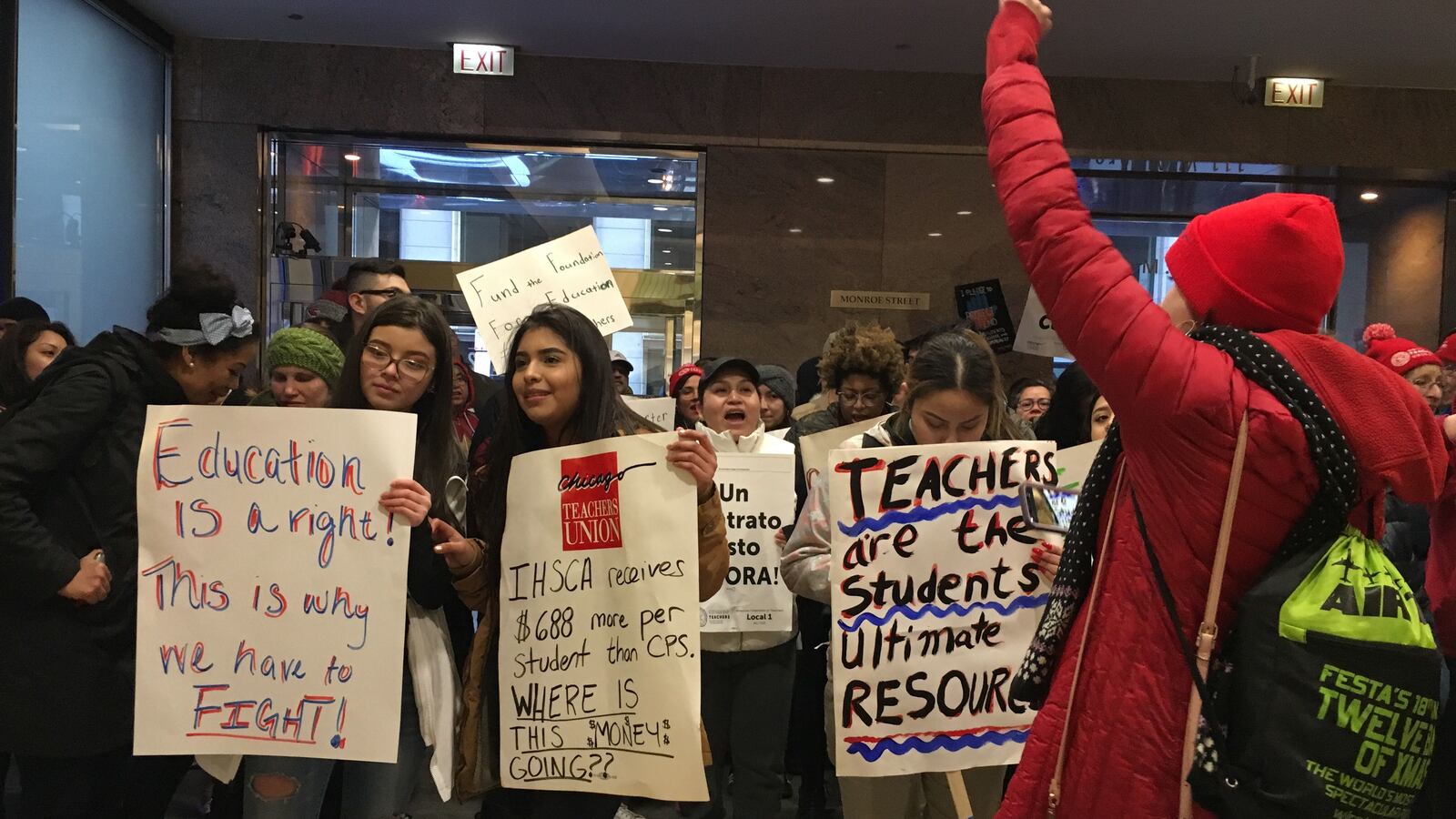As the Chicago Teachers Union announced that educators at five more charter schools are readying strike votes, frustrated teachers and their student supporters staged a raucous protest Monday to draw attention to their cause.
“Our members are willing and ready to strike if that’s what it takes to put these funds into the classroom,” said Mihir Garud, a ninth-grade financial literacy teacher and treasurer of the Chicago Teachers Union charter division. He and other teachers and students were barred from attending the downtown board meeting of the Instituto Del Progreso Latino network’s two schools.
So about 30 educators and supporters filled the downtown lobby of a BMO Harris Bank to demand that their charter network, Instituto del Progreso Latino, raise teacher pay.
Building on momentum from two successful strikes of charter networks, the teachers union announced that the two Instituto del Progreso Latino schools, the Chicago High School for the Arts, Latino Youth High School and Youth Connection Leadership Academy would vote from April 8 to 11 on authorizing strikes. At those winning more than 50 percent of votes cast, teachers could walk out on May 1.
“We are not going to be treated like second-class citizens,” said Chris Baehrend, chair of the union’s charter division. “This is about improving conditions in the whole charter industry.”
Meanwhile, the union is urging its 21,000 members at district-run schools to put aside money in anticipation of a potential strike, part of a two-pronged strategy that the union hopes will change the education industry in Chicago at large.
The five charter and contract schools announcing strike vote dates represent only a small portion of the charter networks currently in negotiations. Nearly all are either trying to reach agreement on a new contract or negotiating after previous contracts expired over the summer. At one school, Urban Prep, the teachers’ labor agreement expired in November.
Here’s a rundown of which operators are negotiating now:
- The Chicago High School for the Arts, also known as ChiArts, is a contract school on the West Side negotiating its first labor agreement.
- Instituto del Progreso Latino runs two high schools for nearly 1,000 students on the South West side. Both schools are bargaining on the same contract.
- Namaste is a one-school charter in McKinley Park negotiating its first contract.
- Youth Connection Charter School contracts with several entities to run its 19 charter schools around the state. In Chicago, it has three schools where teachers are represented by the union: one run by Aspira, another run by Pilsen Wellness Center, and the Youth Connection Leadership Academy is run directly by the network.
- Teachers at three schools owned and managed by Aspira are bargaining one contract together, along with another school owned by Youth Connection Charter School but run by Aspira.
- Pilsen Wellness Center runs one high school, Latino Youth High School, that is owned by Youth Connection Charter School.
- Urban Prep operates three all-male charter high schools. The district voted to close one of its school, Urban Prep West, but was overruled by the state charter commission last week. Union officials say the labor agreement is likely to remain in place.
Among the demands of the groups are more resources for classrooms, a pay bump that would bring their wages closer to that of district-employed teachers, and better counseling or nursing support for students.
Chicago has been at the forefront of the charter labor movement. It was home to the first-ever charter teachers strike, at Acero schools in December, and a second one at four Chicago International Charter Schools in February.
Experts say this is only the start of a broader trend of non-unionized teachers, or those in more precarious jobs at charter schools, turning to unions as a way to improve working conditions.
“More charter teachers may strongly consider organizing after seeing what a short strike can get them,” said Steven Ashby, a labor professor at the University of Illinois at Urbana-Champaign. “For those that are already unionized, I think they may be less likely to take tiny, incremental change, and instead look at the example of Chicago and say: Look, we can really win.”
For Aurelius Raines II, an 11th- and 12th-grade physics teacher at Instituto Health Sciences Career Academy, the threat of a strike was one of the few options he saw to force management to deal with dire teacher turnover after more than six months of negotiations.
“I have had to go into classrooms and teach classes where students have had substitute teachers for weeks,” Raines said. “It is unacceptable. I shouldn’t have to fight with my administration to educate my students.”

